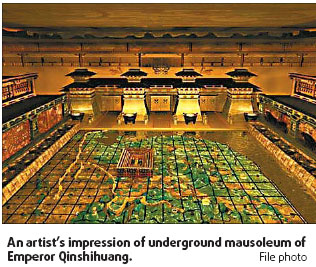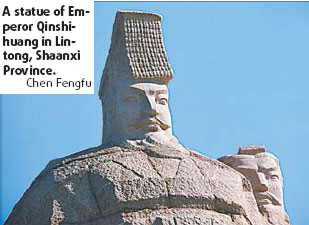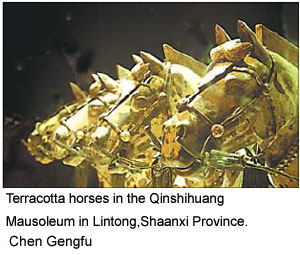| Tools: Save | Print | E-mail | Most Read |
| The Remains of His Day |
| Adjust font size: |
Seen from afar, the mausoleum is a hill overgrown with vegetation. It is believed that the tomb consists of an interior city and an exterior city.
The first emperor of the Qin Dynasty (221-206 BC), Qinshihuang (259-210 BC) was also the first emperor to unite the whole of China under a single empire. Throughout the ages, his mausoleum has intrigued many people, and what lies buried underneath the ground there has aroused the imagination of many others.
But this modern-day celluloid myth has very little in common with the real picture. Archaeological technology, which will guarantee that the cultural relics buried in the tomb will not be harmed in the process of an excavation, is a long way away. Thus the mausoleum has not yet been excavated, silently lying in the eastern suburbs of Lintong County, 35 kilometers east of Xi'an, on the Lishan Mountain and overlooking the Weihe River, for more than two millennia.
The grandeur and mystery surrounding the emperor's Terracotta Warriors and Horses are overwhelming and thus people have generally neglected the yet unexcavated mausoleum of itself. Actually, the Museum of Terracotta Warriors is only a part of the entire tomb. Thanks to certain advances in excavation technology, archaeologists have recently detected some mysterious subterranean structures in the mausoleum. After five years of research with remote sensing mechanisms and geophysical detection technology, a 30-meter-high platform has been discovered under the pyramid-like earthen mound above the underground palace. Experts say that in the history of Chinese tombs and cenotaphs this particular grave is unique. According to Duan Qingbo, the leading member of an archaeological team studying the mausoleum and a researcher with the Shaanxi Provincial Institute of Archaeology (SPIA), the high platform is a stair-like structure made of compressed earth. It stands 30 meters tall, which is as high as a modern building with 10 floors. Experts believe the structure was originally built with the vision that the emperor's soul could travel outside the mausoleum. Duan says the structure has a rectangular base and a 6- to 8-centimeter thick wall-like construction encircling the whole tomb. It has a tapering figure, with a wide base and a narrow top. There are two gaps in the middle of the eastern and western boundaries respectively, which coincide with two pathways leading to the underground palace, where the emperor's coffin, precious items and a huge map demarcating the length and breadth of his empire, are supposed to be buried.
The earthen mound rising above the ground is the largest among the mausoleums of ancient Chinese emperors, spanning 350 meters at the base, and with a height of 51 meters. Situated under the mound, the underground palace stretches 80 meters from east to west, and 50 meters from north to south, with a 15-meter high ceiling. Its base goes 30 meters under the ground. It is believed that the earthen mound, including the structures on it, could only have been constructed after the completion of the underground palace. As Duan puts it, some structures made of tiles and wood may exist in the stairs leading to the platform. But owing to the lack of appropriate technology, it has been impossible to excavate the huge earthen mound that covers the platform. "We guess that the platform was completed before the emperor's death. After he died and was buried at the site, the platform was pulled down and covered with compressed earth," says Duan. "The high platform under the earthen mound is unprecedented as far as burial archaeological studies relating to ancient China are concerned. We have conducted various field explorations and surveys, which have finally confirmed our discovery." In the period before Emperor Qinshihuang, the Chinese built low platforms directly above royal graves without the presence of any earthen mound. Three-step platforms had not been built till the Warring States period (475-221 BC). The style of the grave is also special. Other royal tombs sometimes had an earthen mound. However, cenotaphs were not built directly above the coffin chambers. Due to this unique character, archaeologists suspect that the Qin Dynasty's empire located on the eastern fringes of the Silk Route was influenced by and drew lessons from other cultures in the west of China. During a stint as a visiting scholar in the United States, Duan found clues assisting him in his investigation. Duan says the Mausoleum of Emperor Qinshihuang has quite a few similarities with the Mausoleum at Halicarnassus, one of the Seven Wonders of the Ancient World. Halicarnassus (present-day Bodrum) was an ancient Greek city in the Aegean Sea, and is now part of southwestern Turkey. The famous mausoleum was completed around 350 BC under the aegis of Persian rule. It did not survive after the 16th century. According to some archaeological research since the mid 19th century, led by C.T. Newton, the Mausoleum at Halicarnassus had three major parts, which were a high platform at the base of the mausoleum, a spiral corridor and a pyramid-like top. The high platform and the spiral corridor are features common to both mausoleums. "However, we cannot assert that some relations indeed exist between the two mausoleums," concludes Duan. As a matter of fact, some other evidence suggests that there were interactions between the Qin Dynasty and other Western civilizations. Remains discovered in a 2,200-year-old worker's tomb, 2 kilometers east of the Mausoleum of Emperor Qinshihuang, near the Terracotta Warriors compound, corroborates this fact. A DNA detection of the remains led to a startling discovery. The remains could be linked to West-Eurasian genetic groups. This particular worker was probably part of the team of hundreds of thousands of laborers who had been employed to build the mausoleum. "It shows that East Asian people and people from the western part of Eurasia began frequent interactions a long time ago. Thus cultural exchanges and transfer of knowledge between them are highly possible," says Wang Jianxin, an archaeologist with China's Northwestern University. Emperor Qinshihuang did not realize that the dynasty he had founded would survive a little more than three decades or so. However, he wanted his tomb to survive the onslaught of warriors and tomb raiders. He himself supervised the construction of his tomb, and to keep its secrets, just like the ancient pharaohs of Egypt, he is believed to have buried alive the workers involved in the design and execution of the project. "Emperor Qinshihuang was to some extent a real revolutionary, who always had extraordinary ideas," says Liu Qingzhu, a researcher with China's Academy of Social Sciences. "So it is not surprising that his mausoleum has strange structures." As the tomb of Emperor Qinshihuang has remained intact for 2,200 years and more, the myths surrounding it become more exaggerated. The ancient emperor has already astonished the world 33 years ago, when his Terracotta Warriors were discovered. So it is not entirely surprising that the public expects the eccentric first emperor of China to have more tricks up his sleeve, or maybe just buried underground. Stumbling Upon Ancient Wonder
No one ever expected that this accidental discovery would prove to be one of the most significant modern archaeological finds, adding greater understanding to China's history and at the same time unfolding a unique and majestic spectacle before the world. Excavation of the vault revealed thousands of warriors and their horses, an entire army designed to follow its emperor into eternity. The site is located 1.5 kilometers east of the Qinshihuang Mausoleum. The emperor's terracotta army was found in three underground timber lined vaults. Pit 1 contained chariots and ranks of 6,000 soldiers. Pit 2 held 1,400 figures of cavalrymen, horses and infantrymen, along with 90 wooden chariots. Pit 3 contained about 70 figures. Excavating them has been a massive undertaking. To date, more than 1,000 warriors have been reassembled. The Qin Terracotta Army Museum, a hangar-like building constructed over Pit 1, place of the original discovery in 1974, opened in 1979. Later in October 1994, Pit 2 opened to the public. (China Daily July 11, 2007) |
| Tools: Save | Print | E-mail | Most Read |
 |
| Related Stories |




